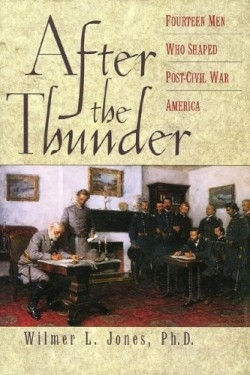After the Thunder
Fourteen Men Who Shaped Post-Civil War America
“On the eve of a new era when there is to be a great harmony between the Federal and the Confederate… Let us have peace.” With these words, Ulysses S. Grant closed his memoirs and echoed the shared sentiment of countless others as the curtain fell on the Civil War and the country prepared to reunite. It was time to make repairs. Reunification of the North and South seemed impossible, but necessary. Jones highlights fourteen men whose careers and personalities steered the fragile Union in both the political and military spheres from the first shot at Fort Sumter until the beginning of the twentieth century.
Jones’ group is mostly a military one, the major players including Robert E. Lee, Ulysses S. Grant, James Longstreet, W. T. Sherman, but also includes two presidents: Andrew Johnson and Jefferson Davis. Jones details each man’s personal history, educational background and even romantic life. He weaves these men together by their commonality: a love of excitement, an affinity for battle and strategy and extensive experiences with loss. Amazingly, these men remained involved in both the military and political future of the nation despite their exhausting wartime experiences.
Readers will also find this is a story of husbands and wives who remained steadfastly united through time, distance and the strain of warfare. For the most part, each man had a strong, supportive wife with which to pass through his sometimes tumultuous life.
The chapters about the lesser known players such as Nathan Bedford Forrest, Joshua Lawrence Chamberlain and John Singleton Mosby are Jones’ gems. Forrest’s participation in the Ku Klux Klan clearly overshadowed his strategic abilities. Mosby, who led an elite guerrilla force known as “Mosby’s Rangers,” was an almost comical “thorn” in the Union’s side. The stories of his numerous narrow escapes are dampened only by his seriousness about the discipline of his men. The most interesting and exciting battle stories belong to Chamberlain, a college professor who in the midst of a promising academic career, volunteered for the Union army and became a military hero. Wounded twice, Chamberlain continued to fight, rallying his men despite near fatal injuries. He seems to overshadow even Lee in gallantry and determination. His talent on the battlefield made his return to civilian life somewhat disappointing.
As a student of the Civil War for over forty years and a member of the Baltimore Civil War Roundtable, Jones is able to bring the Civil War and the Reconstruction into sharper focus through the lives of these fourteen influential men. After the Thunder is intended for the general reader who is interested in a more personalized account and includes a helpful chronology of the period.
Reviewed by
Kristin Putchinksi
Disclosure: This article is not an endorsement, but a review. The publisher of this book provided free copies of the book to have their book reviewed by a professional reviewer. No fee was paid by the publisher for this review. Foreword Reviews only recommends books that we love. Foreword Magazine, Inc. is disclosing this in accordance with the Federal Trade Commission’s 16 CFR, Part 255.

